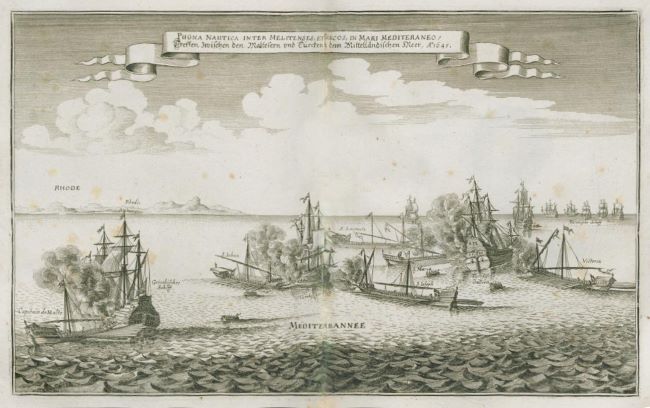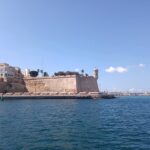Illustration:
This illustration, titled “Naval Battle between the Maltese and Turks in the Mediterranean Sea” (German: “Engagement between the Maltese and Turks in the Mediterranean Sea”), shows the famous sea battle of September 28, 1644 (though mistakenly dated 1645 in the caption). Here, a convoy of Turkish ships traveling from Constantinople to Alexandria—carrying pilgrims bound for Mecca—comes under attack by the Knights Hospitaller of Malta.
On the left, a galley marked “Capitaine de Malte” (“Maltese captain”) confronts a ship labeled “Griechisches Schiff” (“Greek ship”). At the center, two ships, “S. Iohann” and “S. Ioseph,” engage a Turkish ship named “Türckisches Schiff” (“Turkish ship”). On the right, three Maltese galleys—”S. Laurentz,” “S. Maria,” and “Victoria”—encircle a large vessel labeled “Türckische Gallion” (“Turkish galleon”). In the background, additional Turkish ships labeled “Türckische Schiff” (“Turkish ships”) appear near land marked as “Rhode” in German and “Rhodis” in Latin, representing “Rhodes.” The sea is titled “Mediterrannee.”
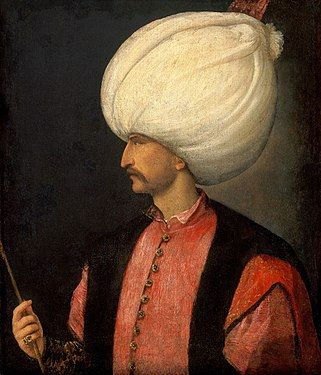
This illustration captures a chaotic yet strategic naval confrontation, highlighting the Knights’ relentless commitment to disrupting Ottoman routes in the Mediterranean.
Context: The Great Siege
In the mid-16th century, under Sultan Suleiman’s rule, the Ottoman Empire sought to dominate the Mediterranean, targeting Malta as a crucial strategic position. The Knights Hospitaller, having established Malta as their stronghold after fleeing Rhodes, continuously disrupted Ottoman maritime operations with tactics similar to those employed by Maltese pirates. The 1565 siege was a strategic necessity for the Ottomans, intended to secure their western flank with what they assumed would be a quick victory.
However, the defeat at Malta forced a profound rethink within the Ottoman ranks, affecting their military strategies, internal politics, and the trajectory of their future campaigns.
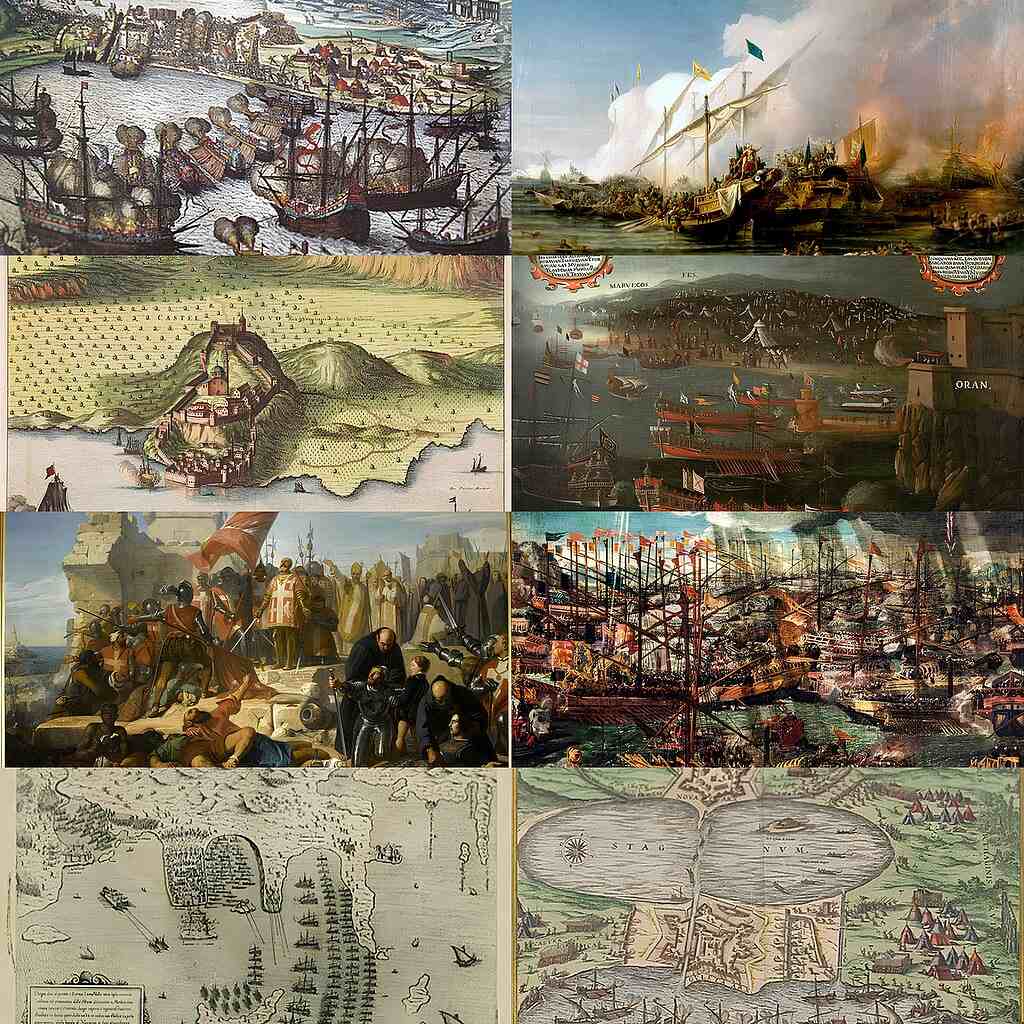
What happened to the Ottomans after the Great Siege?
Post-Siege Ottoman Strategy:
The failure to take Malta had wide-reaching effects. It prompted the Ottomans to reassess their military tactics, as explored in the military tactics during the Great Siege. This defeat was a significant blow, leading to a strategic pivot away from the Mediterranean West.
Leadership Transition:
The death of Suleiman during the Siege of Szigetvár in 1566 marked a turning point; with the new leadership under Selim II, the empire reassessed its military tactics and redirected focus from western Mediterranean expansion to consolidating power in areas like Cyprus and Persia.
Fortification of Malta:
The Knights Hospitaller, emboldened by their victory, further fortified the island. The Three Cities, especially Birgu, became symbols of resilience and strategic importance, as discussed in Birgu’s enduring legacy.
The Impact on Mediterranean Power Dynamics:
- Battle of Lepanto: While Malta did not fight at Lepanto, its victory had inspired the formation of the Holy League, which achieved a landmark naval victory against the Ottomans in 1571. This battle is contextualized in comparative military tactics discussions.
- Ottoman Naval Decline: After Lepanto, the Ottoman navy was weakened, and Malta’s strategic location helped maintain European naval presence in the area.
- War of Cyprus & Battle of Lepanto: The War of Cyprus began in 1570, only five years after the Great Siege of Malta. Though the Ottomans successfully captured Cyprus, they faced a significant naval setback during the Battle of Lepanto in 1571. This battle marked the first major naval defeat for the Ottomans since the 15th century. While they quickly rebuilt their fleet, the loss of nearly 20,000 experienced seamen proved irreplaceable. Despite the setback, the Ottomans managed to capture Tunis in 1574, demonstrating their resilience but also their overstretched resources.
Malta’s Rising Influence:
- Economic and Military Hub: The Three Cities evolved into critical centers for trade and military operations, as explained in the history of why the Knights built the Three Fortress Cities.
- Fortification and Defense: The island’s fortifications were enhanced to make another siege virtually impossible, with structures like Fort St. Angelo becoming both military and cultural icons.
- European Sympathy & Valletta’s Construction: The Maltese victory against the Ottomans sparked a wave of sympathy and financial support across Europe. This influx of funds allowed the Knights Hospitaller to not only rebuild Fort Saint Elmo but also construct an entirely new fortified city, Valletta, named in honor of Grand Master Jean de Valette. The new fortifications made Malta an impregnable fortress, one that would be nearly impossible for any attacker to capture. The transformation of Valletta into a formidable stronghold ensured that the Ottomans, humbled by their defeats in Malta and Lepanto, saw little reason to attempt another assault on an island now even better fortified.
Shift in Ottoman Focus:
- Eastern Expansion: The Ottomans redirected their expansionist gaze eastward, focusing on Persia and the Indian Ocean to counterbalance their losses in the Mediterranean.
- Legacy of the Siege: The Great Siege became a lesson in the limits of Ottoman military might, leading to a more cautious approach to future conflicts.
- Constant Engagements & Lack of Return to Malta: One of the main reasons the Ottomans never attempted another siege of Malta was their constant engagement in other conflicts. Following 1565, the Empire found itself involved in the Long War against Austria, the Polish-Ottoman Wars, and conflicts with the Safavid Empire in Persia. The extensive demands on Ottoman military resources and leadership left little room for revisiting Malta, which no longer held the same strategic allure compared to other pressing priorities.
- Ottoman Mediterranean Dominance Until 1630s: Despite setbacks such as the Battle of Lepanto, the Ottoman Empire continued to exert formidable naval power in the Mediterranean until the 1630s. They captured Madeira in 1617 and raided far into Western Europe with minimal resistance. This period of maritime dominance, despite the losses in major engagements, underscores the resilience and capacity of the Ottoman navy, even as it faced new challenges and the changing strategic landscape of the Mediterranean.
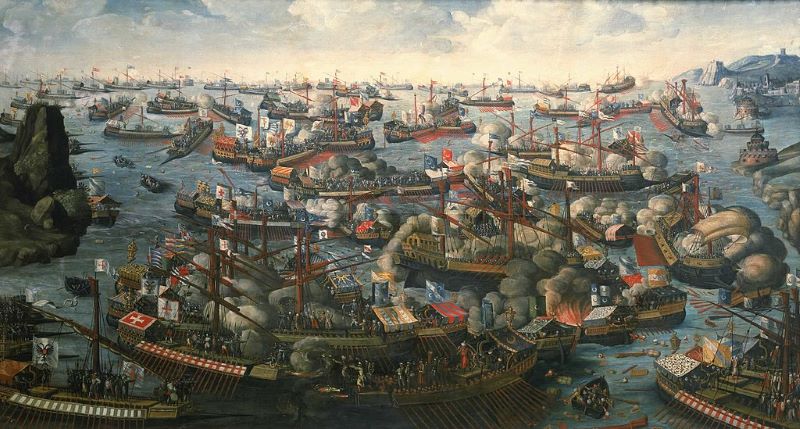
I. Military Repercussions for the Ottomans
A. Reassessment of Siege Warfare
The Ottoman military’s reputation was forged in sieges like Rhodes. However, during the Great Siege of Malta, the Knights Hospitaller’s fortifications, notably in Bormla’s and other Three Cities’ defenses, exposed limitations in Ottoman siege tactics.
- The failure led to a significant reassessment of their approach, with a new emphasis on engineering and intelligence gathering. This is reflected in the comparative study of tactics employed in Malta and later sieges.
- The Ottomans took note of the defensive tactics, which included the effective use of counter-mines and artillery from Senglea.
B. Loss of Elite Forces
- The siege resulted in high casualties, significantly among the Janissaries, as discussed in the context of Malta’s resilience.
- The death of Dragut Reis, a key figure in Ottoman naval strategy, forced a reevaluation of naval tactics and leadership.
II. Leadership and Political Consequences
A. Scapegoating and Internal Strife
- Mustafa Pasha’s fall from grace after the siege highlights the political fallout, which led to a reexamination of military leadership appointments.
- The internal discord can be paralleled with later conflicts like the French invasion, where Maltese resistance similarly reshaped local governance.
B. Sultan Suleiman’s Reaction
- Suleiman’s response included punitive actions, as seen in his handling of perceived traitors, reflecting a broader theme of Maltese resistance against foreign domination.
- His strategic pivot to the East is a testament to how Malta’s victory altered Ottoman expansion plans.
- Suleiman the Magnificent, whose ambition had driven the Siege of Malta, died in 1566, only a year after the failed campaign. His successor, Selim II, brought a shift in focus for the Ottoman Empire. Instead of revisiting Malta, Selim directed his attention to Cyprus, an equally strategic island in the Mediterranean, seen as a vital asset for controlling eastern maritime routes.
III. Strategic Shifts in Expansion Policy
A. Halt in Western Mediterranean Expansion
- The defeat at Malta was a significant factor in the Ottomans’ strategic retreat from Mediterranean ambitions, shifting focus to more accessible territories.
- This shift influenced subsequent military engagements, such as the Siege of Osaka, where similar lessons might have been considered.
B. Impact on Naval Dominance
- The Ottoman navy’s performance during and after Malta led to reforms in naval tactics, learning from both their own and the Knights’ strategies.
IV. Psychological and Cultural Impact
A. Erosion of Invincibility Myth
- The myth of Ottoman invincibility was shattered, emboldening European states and leading to increased resistance, which can be seen in events like the blockade of the Three Cities against the French.
- This psychological blow affected how the Ottomans approached future conflicts, with a more cautious strategy exemplified in other sieges.
V. Cultural and Economic Impacts
- The defeat was not only a military setback but also an economic one. The implications are explored in the financial aspects of the siege.
- Culturally, the siege had a profound impact, influencing Malta’s identity, which is still evident today.

Giuseppe Cali
Conclusion
The Great Siege of Malta forced the Ottoman Empire into a period of reflection and adaptation. It was a catalyst for change in military strategy, political structures, and expansion policies. It also inspired a lasting legacy of resilience among the Maltese, encapsulated in the history of the Three Cities before the Knights, which predates even the Order’s arrival.
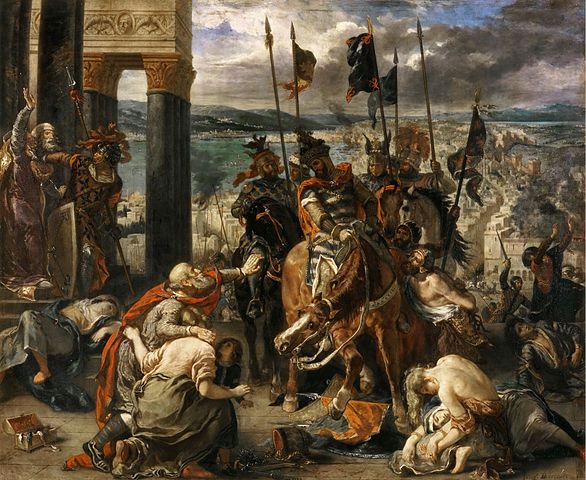
Closing Thoughts
The siege of Malta is a testament to the power of strategic defense and the indomitable spirit of a people. It not only shaped the future of the Ottoman Empire but also highlighted the Knights Hospitaller’s role as Europe’s first pan-European organization. The lessons from Malta reverberated through history, teaching the value of adaptability, intelligence, and unity in the face of overwhelming odds.
This revised version keeps the focus on the historical details, interlinks the provided URLs, and does not include Wikipedia links, maintaining the narrative’s flow while enhancing it with direct connections to your specified resources.
References
Bradford, Ernle. The Great Siege: Malta 1565. Wordsworth Editions, 1999.
Butler, Desmond. The Mediterranean and the Mediterranean World in the Age of Philip II. New York: Viking Press, 1973.
Casale, Giancarlo. The Ottoman Age of Exploration. Oxford University Press, 2010.
Galea, Joseph. The Great Siege of Malta from a Turkish Point of View. University of Malta. Accessed April 27, 2024. Available here.
Green, Thomas A. The Rise of the Ottomans: Studies in the History of Turkey, Thirteenth to Fifteenth Centuries. London: Variorum, 1994.
MalliaMilanes, Victor. “Why Did the Ottomans Besiege Malta in 1565?” 2008. University of Malta. Accessed April 27, 2024. Read the full paper.
Setton, Kenneth M. The Papacy and the Levant (1204–1571), Volume IV: The Sixteenth Century. Philadelphia: American Philosophical Society, 1984.
Shaw, Stanford J. History of the Ottoman Empire and Modern Turkey: Volume 1, Empire of the Gazis: The Rise and Decline of the Ottoman Empire 1280–1808. Cambridge: Cambridge University Press, 1976.
Spiteri, Stephen C. The Great Siege: Knights vs. Turks, 1565. Malta: BDL Publishing, 2005.
Vella Bonavita, Helen. “Key to Christendom: The 1565 Siege of Malta, Its Histories, and Their Use in Reformation Polemic.” The Sixteenth Century Journal 33, no. 4 (2002): 1021–1043. Accessed April 27, 2024. Available on JSTOR.

